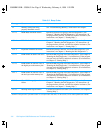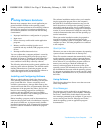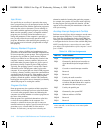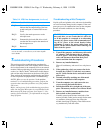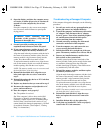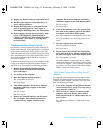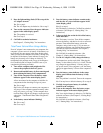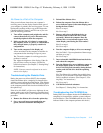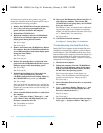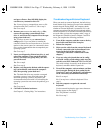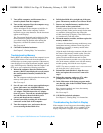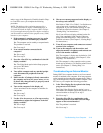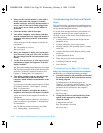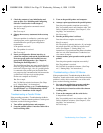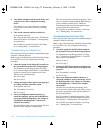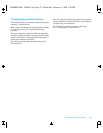
3-16 Dell Inspiron 3000 Reference and Troubleshooting Guide
If a failure occurs with the drive, make a copy of the
Diagnostics Checklist found in Chapter 5 and fill it out as
you complete the following procedure:
1. Remove the CD-ROM drive from the options bay.
2. Save your work in any open application pro-
grams, and then shut down the computer.
3. Reinstall the CD-ROM drive.
4. Reboot the computer. Does the CD-ROM/hard-
disk drive access indicator appear in the status
display panel during the boot routine.
Yes. Go to step 6.
No. Go to step 5.
5. Remove and reinsert the CD-ROM drive. Reboot
the computer. Does the CD-ROM/hard-disk drive
access indicator appear in the status display panel
during the boot routine?
Yes. Go to step 6.
No. Go to step 10.
6. Remove the hard-disk drive, and boot the com-
puter. Does the CD-ROM/hard-disk drive access
indicator appear in the status display panel?
Yes. Go to step 7.
No. Go to step 10.
7. Reinstall the hard-disk drive. Then check the
config.sys file (in Windows 95, check the
CD-ROM configuration in the Settings folder). Is
the CD-ROM driver (tsycdrom.sys) installed?
Yes. Go to step 8.
No. Load the driver, and return to step 1 to begin this
procedure again. (To load the driver, use the program
diskette sets you made when you first received your
Dell computer.)
8. Insert a bootable diskette into drive A, and reboot
the computer.
9. Type
d:
and press <Enter>. Then type
dir
and
press <Enter>. Does MS-DOS display the root
directory contents for drive D?
Yes. The problem is resolved.
No. Go to step 10.
10. Insert your Dell Diagnostics diskette into drive A,
and reboot the computer. Then run the IDE
CD-ROM Drives test group. Does your CD-ROM
drive pass all the tests?
Yes. Return to step 1, and perform this troubleshoot-
ing procedure again. If you continue to experience
trouble, call Dell for technical assistance. (See Chap-
ter 5, “Getting Help,” for instructions.)
No. Go to step 11.
11. Call Dell for technical assistance.
See Chapter 5, “Getting Help,” for instructions.
Troubleshooting the Hard-Disk Drive
During POST, the computer checks the hard-disk drive,
comparing its characteristics with the system configura-
tion information. (The CD-ROM/hard-disk drive access
indicator blinks as the computer performs this check.) If a
failure occurs with the drive, make a copy of the Diag-
nostics Checklist found in Chapter 5 and fill it out as you
complete the following procedure:
1. Shut down the computer.
2. Reboot the computer. Does the CD-ROM/hard-
disk drive access indicator appear in the status
display panel during the boot routine, and does
the drive boot the operating system?
Yes. If a message appears on the display, see
Table 3-2 for an explanation of the message and
possible corrective actions. Then go to step 7.
No. Go to step 3.
3. Insert a bootable diskette into drive A, and reboot
the computer.
4. Type
c:
and press <Enter>. Then type
dir
and
press <Enter>. Does MS-DOS display the root
directory contents for drive C?
Yes. Go to step 6.
No. Go to step 5.
5. If your hard-disk drive has more than one logical
drive, type
d:
and press <Enter>. Then type
dir
55899BK1.BK : 55899c31.fm Page 16 Wednesday, February 4, 1998 1:20 PM



